Amazing Grains In Vegreville, Alberta
Preface: This post is about a recent trip I was fortunate to take with Jan, to Alberta, for a film project with Canadian National Railways that involved some pretty amazing grains. What follows is simply an observation of my experience: I am in no way intentionally promoting or misrepresenting any of the industries or companies involved.
Bird’s Eye View
It is cold at the top of the 100-foot grain elevator, and the wind is whipping around. It is so cold, in fact, that any patch of skin left accidentally exposed for just a few seconds, instantly goes numb and takes about 10 minutes to thaw out (a painful process). Even through 4 layers of thermal underwear, socks, boots, parkas, hats, hoods, and gloves, we are still…cold.
The view from the top is dizzying: it is a l-o-o-n-g way down. From where we stand, there is nothing but wide, open sky; grids of frozen farm fields stretch out as far as the eye can see, interspersed with lines of trees to break up the monotony. But, it is beautiful, in a stark kind of way.
Below us, a string of 100 shiny, silver grain “hopper” cars slowly work their way around a loop of track, pulled by a large locomotive car, through the grain elevator to receive a shipment of wheat.
Hopping Around
These hopper cars are special for a few reasons, and not just because they are so unbelievably shiny. Canadian National Railways (“CN Rail,” for short), commissioned the creation of these cars to replace a slew of their aging and ailing fleet. Current cars, if you ever catch a glimpse of them, look tired, rusty, and are often covered in graffiti. These new cars are crisp, clean, and a beautiful blank canvas to work with (kidding!!!!!!! …but doesn’t your brain go there too? O:-)). And, this is just the beginning! There are 400 more cars just like this string of 100, coming down the track soon.
The cars, being state-of-the-art (what “state-of-the-art” means for a steel grain car produced in the 21st century, I could not tell you) are also larger in size than their older counterparts. At 13% bigger, this means they can hold more amazing grains, which, looking at the grand scheme of things, presumably means Canadian farmers are able to grow more amazing crops, and theoretically everyone makes out like bandits. How true this is in reality is something I will have to investigate.
But I digress. Where were we? Ah yes, at the top of a grain elevator.
Canada & the World
It is here at the grain elevator that Canadian farmers take their bounty, to be sold at the global marketplace, in far-flung regions of the planet. Places like Sri Lanka, Pakistan, and beyond (no joke).
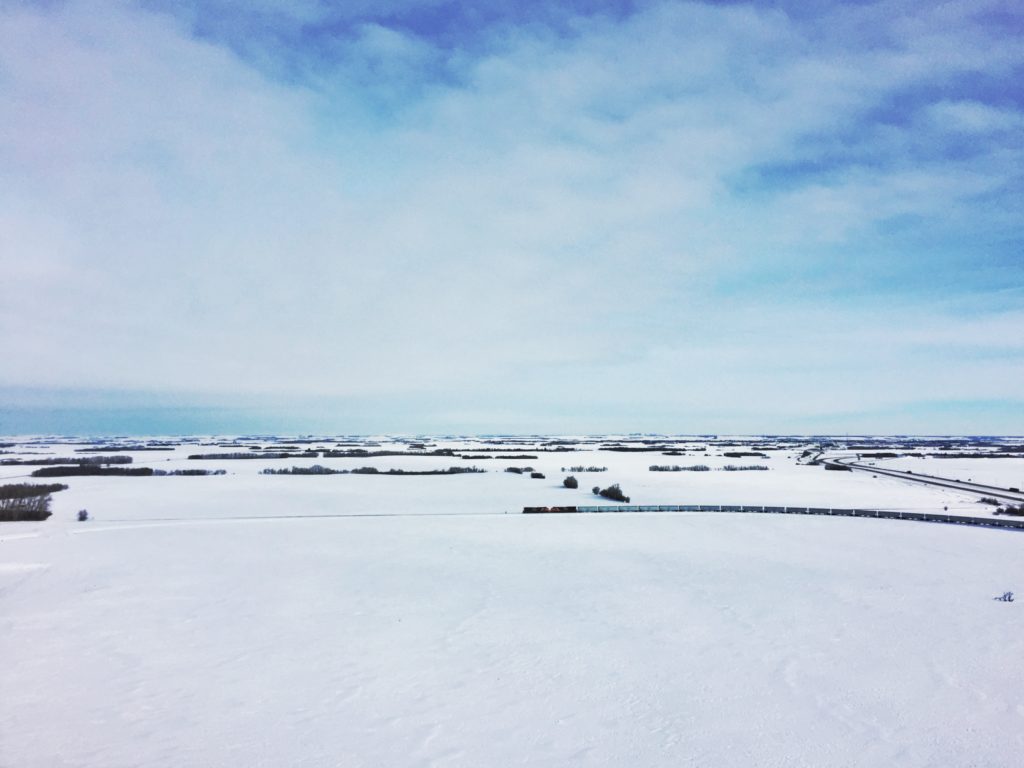
The cars have arrived here in the wee hours of the morning. Already, 15 have been filled by the time we arrive at 9:30AM, at a rate of four minutes per car. It is insanely fast, and yet slow at the same time, upon looking out at the fleet of empty cars waiting to be filled. But, by the time we leave today, the grain elevator will have emptied two of its massive silos into these 100 cars. It is wholly mind-boggling and very difficult to comprehend.
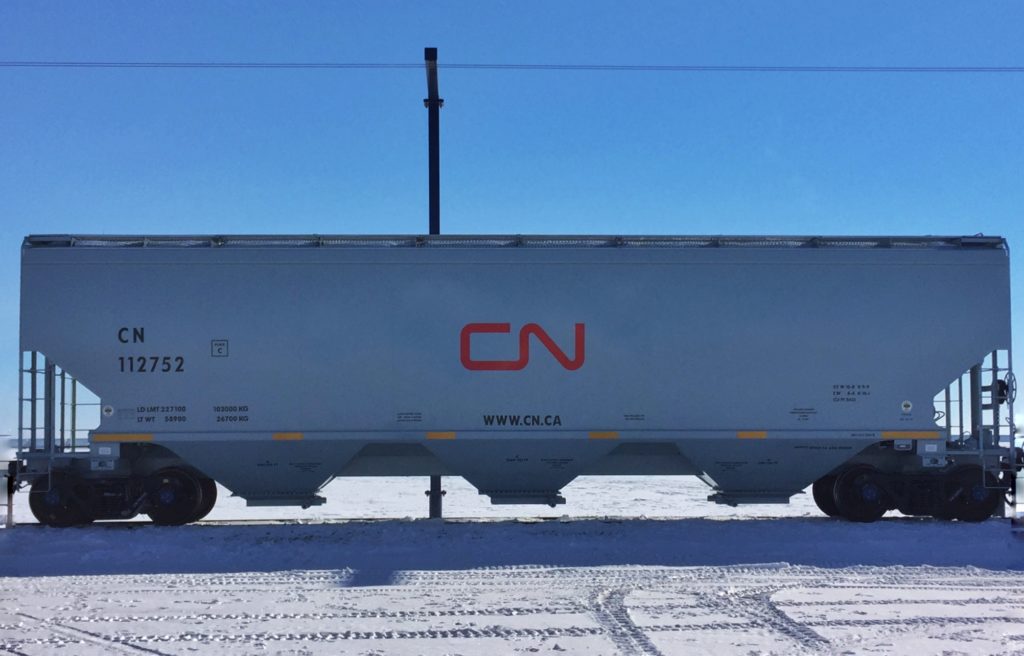
Amazing Grains
The grain elevator we happen to find ourselves at is not just in the wheat business; it stores other amazing grains such as barley, canola, flax, and rye; as well as pulses like peas, lentils, chickpeas, beans, etc.; all from the prairie provinces in Canada (Alberta, Manitoba, and Saskatchewan). Canada, as it turns out, is a leading exporter of grains and pulses and the company that runs this grain elevator, Viterra, is one of the largest in Canada.
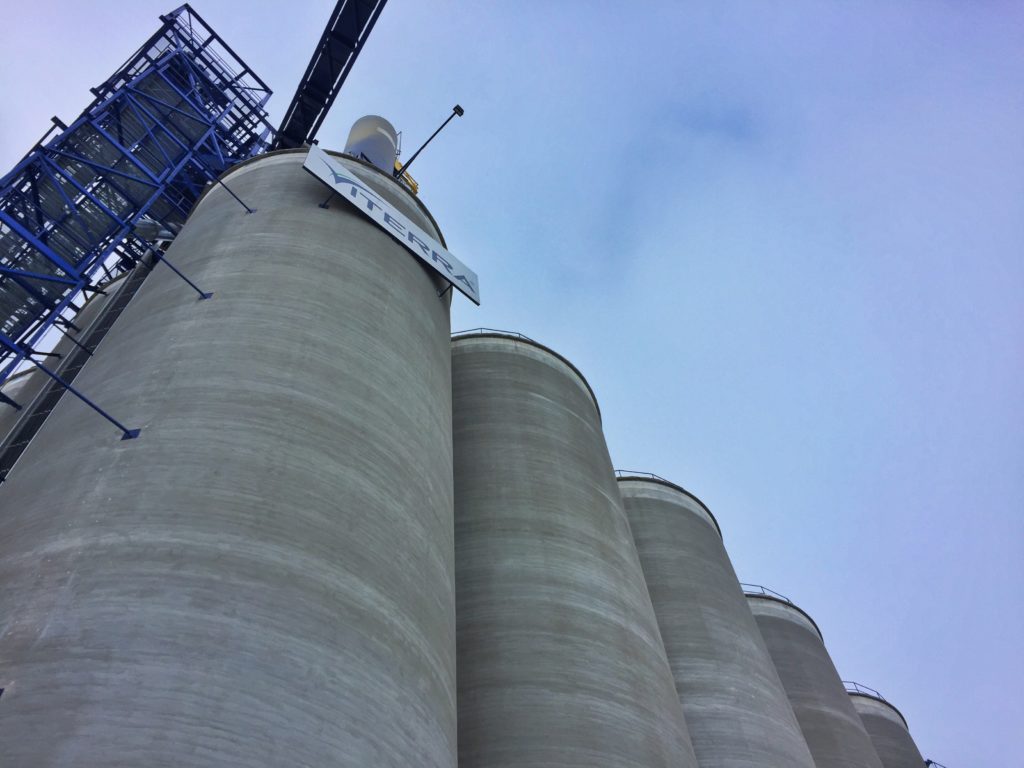
Where’s Waldo?
We are in Vegreville, Alberta and it is -34C, with a wind-chill to boot. What began as a gray-ish morning is turning into a blindingly beautiful day, with blue skies, wispy white clouds, and sunshine bouncing off the hard, crunchy snow pack covering the fields. In front of us stand these 100 gleaming hopper cars, and we are here to film their inaugural fill-up of Canadian-grown wheat.
Our Job, If We Choose to Accept It
We are here to capture this event from start to finish. On the shoot are Jan (the filmmaker) and Pascale (the photographer and producer). I’m here to assist and play hall monitor while interviews are being conducted. Voices down, please!
Over the course of the day, I will watch as they capture footage of grain, of the gleaming line of new cars wrapping around the yard, and of the humans making this magic happen. There is a lot of grain, a lot of steel, and a whole lotta can-do attitude happening around this facility today!
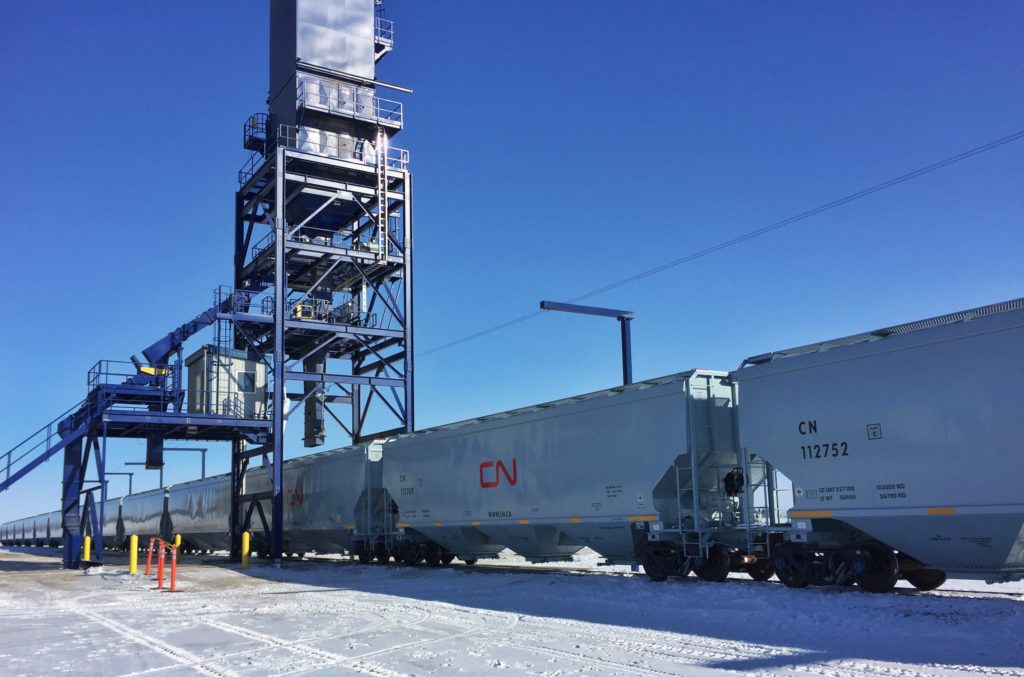
Vegre-wha?
Vegreville is a small town of about 5,000-ish residents, situated roughly 100km east (about an hour drive) from Edmonton, Alberta. It’s probably a bit obvious by now, but this is a farming community. No evidence for this is needed; casual observation will note the fields, the silos dropped in the middle of fields at regular intervals, and the massive combine harvesters for sale at the entrance to town.
The town is small, by most standards (somehow, it still seemed big to me!). There is a sleepy downtown and a few notable cultural sites of interest, including a gigantic pysanka (Ukranian Easter Egg). We will miss seeing the on our trip, but it might just be worth returning for (in the summer). I’m sure it is all it is cracked up to be. 😉
There are a handful of popular and useful chain businesses scattered about, including the ever-present Tim Hortons, Mark’s Work Wearhouse (where I will go to find extra thermal underwear, because I am a goober, and ill-prepared), and Crappy Canadian Tire. Vegreville also boasts a Chinese restaurant that we will eat at twice while there; it is so delicious (ignore the bad reviews; they are all full of it, and the place is under new management anyway)!
Besides a few other small businesses and farmhouses sprinkled across town, this is Vegreville in a nutshell. Or maybe I should say eggshell, or grain husk? 🙂 It is small, quiet, and peaceful.
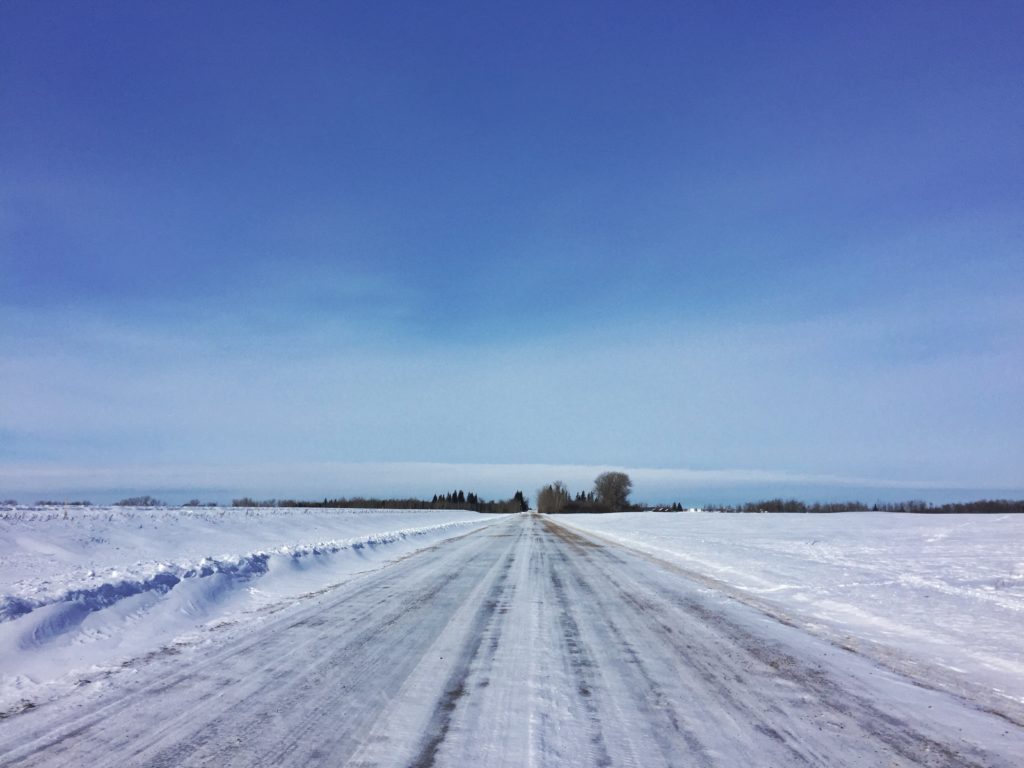
Trains, Grains, and People
Back at Viterra, the place is buzzing. Train-filling days seem to be a busy time, a slow-and-fast dance of people, machinery, and grain. People are in and out of the office all day to warm up, check numbers, or simply to take a breather.
We watch in awe as two young gentlemen take turns preparing the cars for the grain. After securing themselves with fall protection, they dance over each car, swinging open the lids. Once each car has been filled, they snap the lids closed. Two more men sit in a room stationed next to the track, directing the flow of grain into each car as it passes underneath.
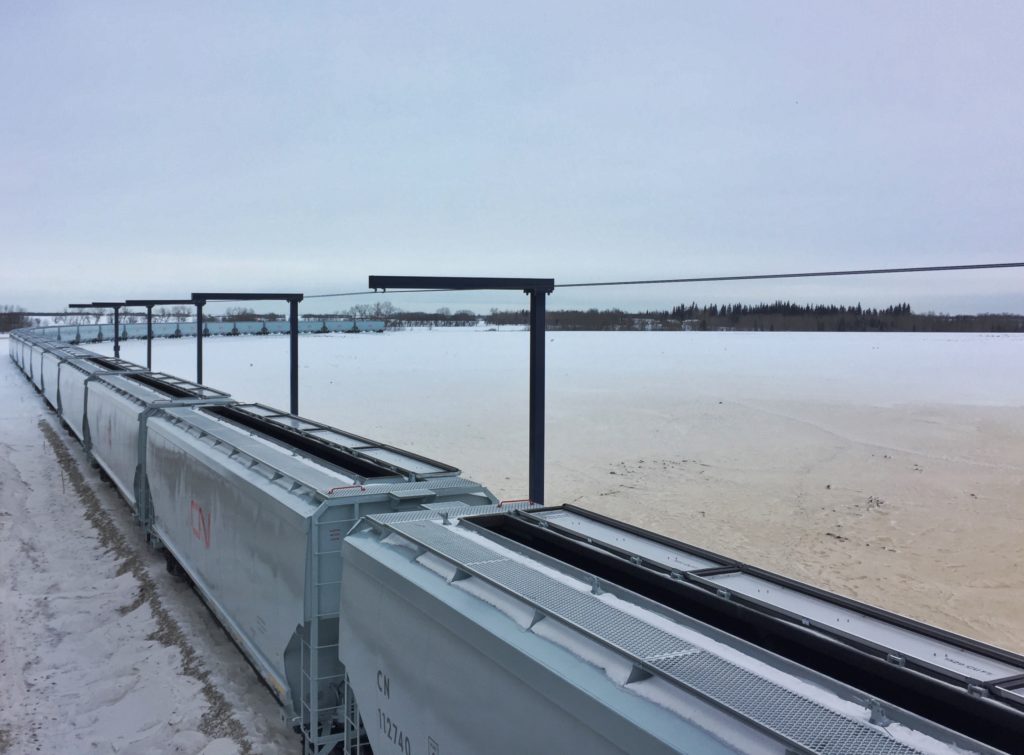
Inside the office, a woman named Jodi practically sprints around her quality control lab. She’s taking samples of grain to ensure protein and moisture levels are up to snuff. With 100 cars to check (remember that 4 min/car rate?), she barely has time to eat. Even a one-minute breather can set her back 20 minutes. The pace of all of this feels fast, frenetic almost, but somehow everybody seems quite calm and collected.
The scale of this entire thing is staggering, yet so tiny and granular at the same time. These are individual grain kernels, after all. At one point Jared, our Viterra tour-guide (and Facilities Operations Manager at Viterra) pulls out a tall, blue, rectangular bin, full of mixed grains to show us the product up close.
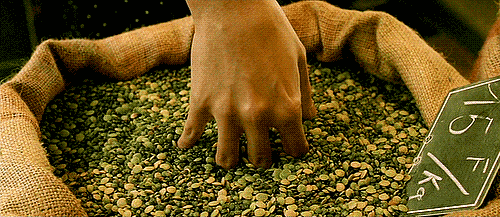
GIF courtesy of little t
A Kernel of Knowledge
Jared walks us through the various types of amazing grains they receive. He shows us how to identify mildew or a hard frost on individual grain kernels. We learn how to point out dead grain (it is black when it should be brown). Jared is a fountain of knowledge. It is here where we learn that canola is a small, circular, purple grain. Who knew? Truly, they really are amazing grains.
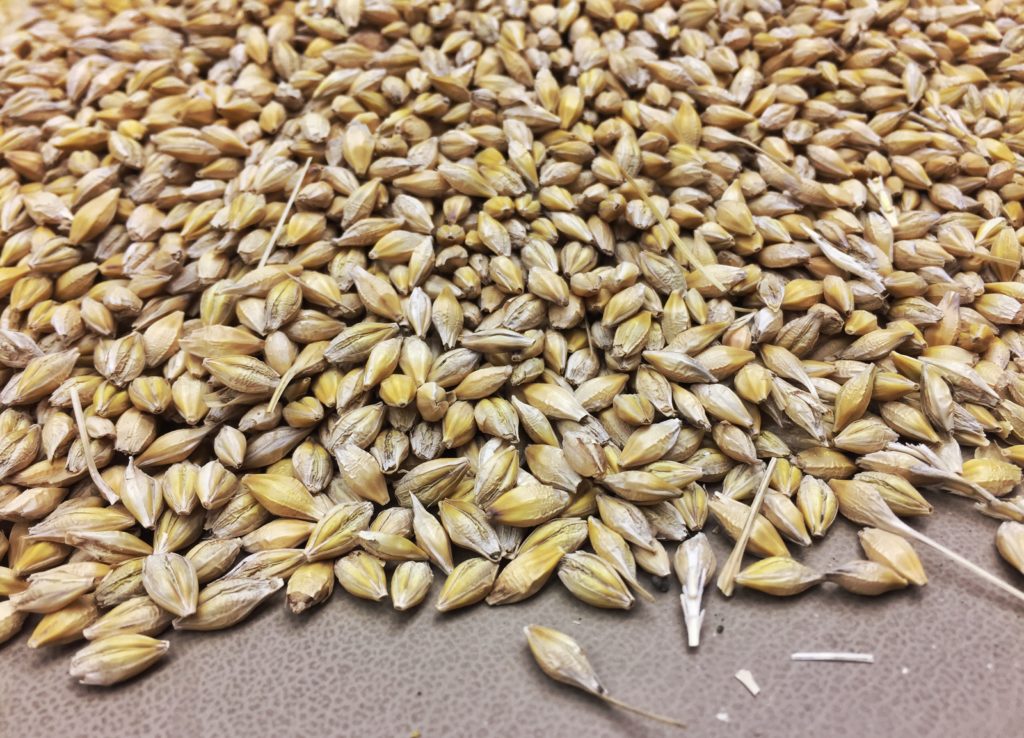
We are joined today by a small contingent of corporate folks who are here for a photo op and tour. Each represents a different facet of this event:
- National Steel Car: the company manufacturing the cars, based in Hamilton, Ontario
- Viterra: the grain handler with grain elevators across Canada and parts of the US
- CN Rail: commissioner of the cars; their trains ship grain and other goods across Canada and into the US
Each company has had a hand in getting these cars to Vegreville, and there is a definite feeling of pride and excitement in the air as these cars make their way through the filling station. I imagine this is how any of us would feel to finally see something we’ve worked so hard to create, come to life before our eyes.
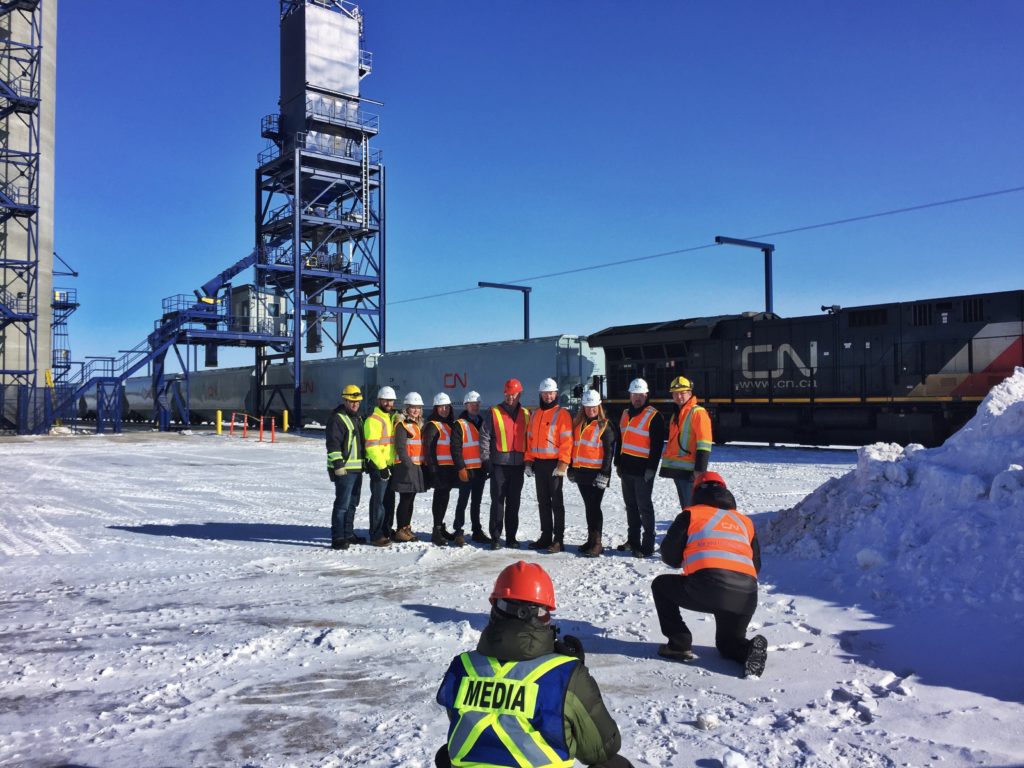
Massive. Yet Small.
It is amazing to witness what is transpiring before our eyes today. Amazing in a “holy moly this is crazy!!” kind of way. We’re watching as global commodities (here, wheat) are preparing to ship from Canada to Sri Lanka. Yes, that is the final destination for all of this wheat, and yes, I have thoughts about this but will share those at a later time.
The point here is that despite the massiveness of it all…it is still very much a human experience. Humans are making it happen. For the people involved, this is their day-to-day; they seem completely nonplussed by the fact that 100 hopper cars have just rolled through to pick up multiple thousands of metric tons of grains. In fact, they seem amused at our giddiness: for us, it is all brand-new. To them, it is routine.
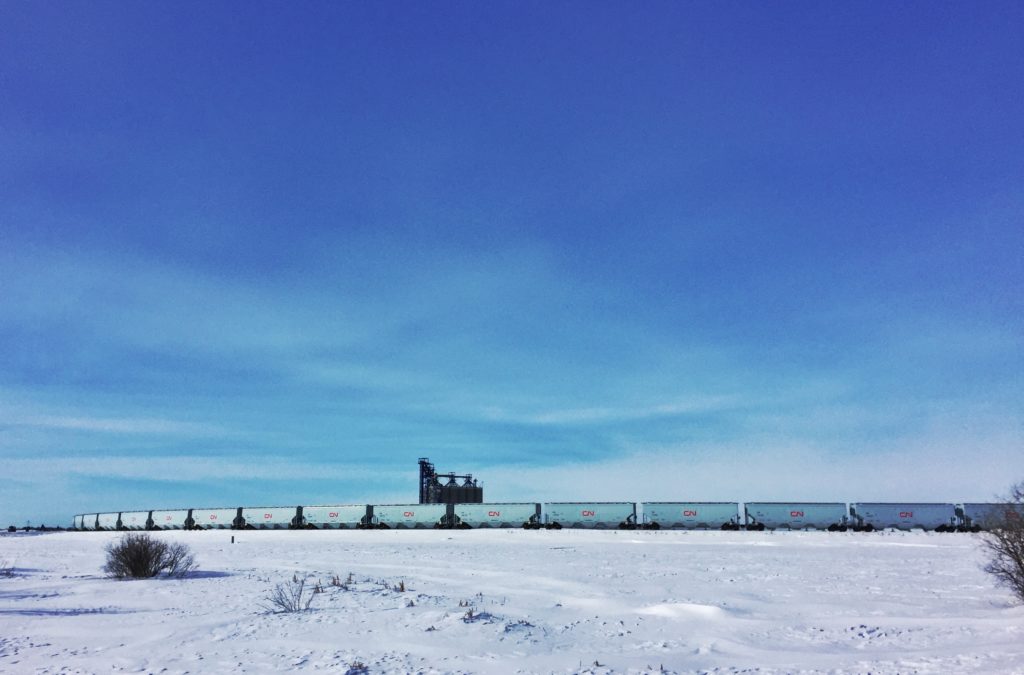
The day passes, and the sun fades. The corporate contingent heads back to their offices across Canada and we race in and out of the office to grab “one last shot” before finally calling it a day as the last glimmers of sun fade below the horizon. Jan and Pascale seem satisfied with what they’ve captured and we’re all thrilled to have met such an amazing group of people today.
On A Roll
This experience has been incredibly eye-opening for all of us. We three have a good sense of the world, but even the scale of this is hard to conceptualize. Witnessing the commodity dance of grain is difficult to rationalize, to wrap our brains around. On one hand, we are grateful to be gaining a perspective not often entrusted to most; on the other, it is unnerving to realize how massive this industry actually is. It is humbling.
For me, this is the best part about work and travel. I relish these glimpses into another world, a “behind the scenes” look at how the world actually works. It provides me with fresh perspective and new ways of looking at not only my own life, but of the way we live our lives across the planet. I’m forming new opinions on how best to tackle some pretty big problems, many involving these very commodity industries.
The gist: this stuff is complicated and endlessly fascinating. I cannot get enough. Amazing grains, amazing perspectives!
To Be Continued…
Once filled, these grain cars will make their way west, to the port of Prince Rupert (in BC). Upon arrival, the amazing grains will be offloaded into even bigger silos. Our work there will be to meet the train at the port and capture the off-loading. Stay tuned for Part II, by the sea!
Footnote: be on the lookout for more of this kind of observational story-telling on this blog, in the coming weeks. This is a writing style that I love but that I am still finessing. Previous examples are here and here...and I hope to improve as I go. Thank you for reading. 🙂

